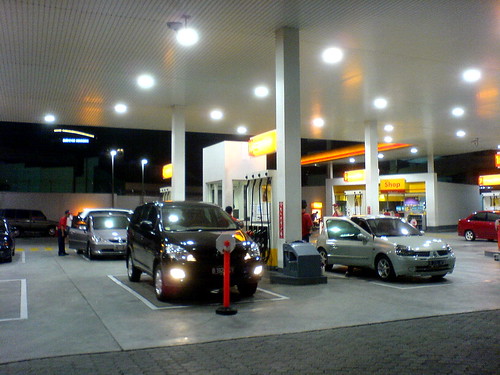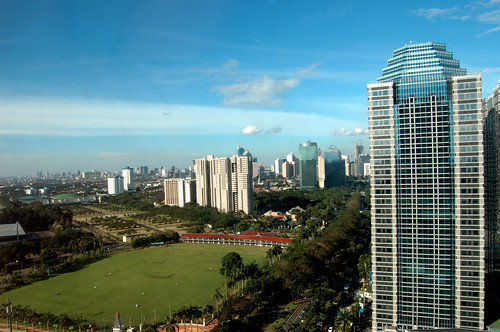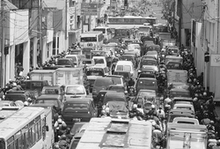Restoring Green Areas in Jakarta
On November 8, 2009 Jakarta’s Governor Fauzi Bowo closed and locked a gas station located on Jl. Jendral Sudirman to symbolically close down 27 gas stations and convert the areas into green spaces. The Jakarta Parks and Cemetery Agency announced that the 27 gas stations will be closed by the end of the year and the closure of these gas stations will add another 10,505 square meters of green areas in Jakarta (The Jakarta Post, November 11, 2009).
The conversion of gas stations into green areas is to meet the target for green areas in Jakarta stipulated in the Jakarta spatial plan 2000-2010 to cover 13.94 percent of Jakarta's total 63,744 hectares by 2010. In 1965, green areas made up more than 35 percent of Jakarta and have been shrinking ever since. Currently, green areas in Jakarta account for only 9.3 percent of the city's area, far below the target of 30 percent set by the Spatial Planning Law 26/2007.
I commend Governor Fauzi Bowo and his city administration for converting gas stations into green areas because of two main reasons. First, the conversion of gas stations into green areas is a good precedent for implementing spatial plans. Over the years, the spatial plan seems to be a legal document that is not fully enforced and implemented. The 27 gas stations are located in the areas designated as green areas in the Jakarta spatial plans 1965-1985, 1985-2005 and 2000-2010. For many years, the city conceded to the powerful owners of the gas stations and could not enforce and implement the spatial plans. In March 2008, the city proposed the plan of the gas stations conversion but it was rejected by the Jakarta City Council. This year, the city resubmitted the proposal and it was approved by the newly elected Jakarta City Council.
Second, we must put a stop to disappearing green areas in Jakarta. Green areas are an important urban element that can help make cities self-sustainable and more livable. Annual floods in Jakarta indicate an urgency for green areas in the capital, because they absorb rainwater and help to avert flooding. New homes, condominiums, malls, hotels and commercial and office buildings have proliferated in Jakarta over the last three decades. These new developments have come at the cost of green areas and have decreased water catchment areas, making the city more prone to floods. Not only will the conversion of gas stations into green areas add the green areas but also contribute in preventing annual floods in Jakarta.
The cost of closing down and converting each gas station was around Rp. 75 million and I would argue that the benefit of the conversion of gas station into green areas will be much more than Rp. 75 million over the years. In addition to reducing the risk of floods, the new green areas will beautify and make Jakarta more livable. I would also suggest that the green areas that are close to residential areas be designed as recreation parks. The recreation parks will serve as a mode to build healthy, strong and vibrant neighborhoods and it will benefit the city even more. The conversion of these gas stations into green areas will also restrain the increasing city's carbon dioxide levels. The green areas can serve act as sponges for such pollutants.
In sum, the decision of the Jakarta’s administration to close down the gas stations and convert them into green areas in order to comply with the Jakarta spatial plan is a good move and should be appreciated. Not only will this decision become a good precedent for implementing the spatial plans in Jakarta or even in other areas in Indonesia, but also will provide a lot of benefits for the city and its residents.
(This article also appeared at The Jakarta Post on December 12, 2009; was reposted at Creative Cities ; was cited at Treehugger and at Reflection on Auckland Planning )






6 comments:
selamat siang, salam kenal....wakh keren blognya, ini adalah kunjungan pertama saya, semoga dengan kunjungan pertama ini bisa menambah silahturahim dan teman sesama blogger. saya baru belajar
Apa kabar, Deden? This is Allison, previously of Tally, now in DC. I saw your blog post from Inside Indonesia on Treehugger.com! Congrats, it looks like you are doing great writing!
hello,
As I was looking over your blog in regards to my research and evaluation of the KIP program, I was wondering, do you believe the scale of slums are currently getting larger in Indonesia?
Thank you!
Victoria
hello,
As I was looking over your blog in regards to my research and evaluation of the KIP program, I was wondering, do you believe the scale of slums are currently getting larger in Indonesia?
Thank you!
Victoria
great blog, sir! :)
just blogwalking.
I'll visit more.
Wow, nice. Jakarta is a bustling town, you can find shopping centres and luxury hotels. Most of the people are involved in plantation, they mostly use motorbike taxis and three wheelers for this purpose. Majority of people work in metal shops, small scale factories and vending food.
Post a Comment